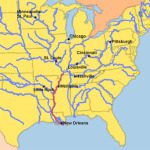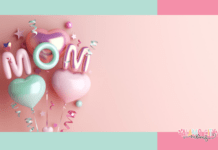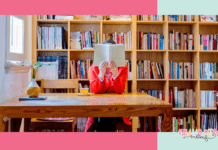 When it comes to Frozen character alliances, I’ve always been Team Anna. We’re both plucky younger sisters who are hungry for love and are running some gray at the hairline.
When it comes to Frozen character alliances, I’ve always been Team Anna. We’re both plucky younger sisters who are hungry for love and are running some gray at the hairline.
It’s not that I actively dislike Elsa. In fact, I kinda admire her. She’s got sovereign authority, icy good looks, and—most importantly—a mastery of fractals.[hr]
Elsa’s fractals are the ice she produces as a result of her powers. The elaborate structures are made of individual crystals, each of which is a reduced-sized copy of the whole.

In technical terms, a fractal is a never-ending pattern (be it natural, man-made, or mathematical) that repeats itself at different scales. You know you are looking at a fractal when you can zoom in and out and see the same shapes at every level.[hr]
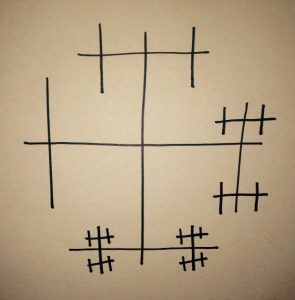 An example will help. Consider the quadratic cross (pictured drawn-in-progress). You make one by drawing a vertical line (long vertical in center) and bisecting it at a right angle (long horizontal line in center). The bisection makes four short segments, each of which you then bisect at a right angle. At this point, you have eight short segments, each of which can be bisected. And so on, and so on ad infinitum.
An example will help. Consider the quadratic cross (pictured drawn-in-progress). You make one by drawing a vertical line (long vertical in center) and bisecting it at a right angle (long horizontal line in center). The bisection makes four short segments, each of which you then bisect at a right angle. At this point, you have eight short segments, each of which can be bisected. And so on, and so on ad infinitum.
By definition, a fractal is never complete, but at any point in the process, you could zoom in or out of the quadratic cross and find yourself on a line that bisects—and is bisected by—another line at a right angle. Each section of the fractal is a reduced-sized copy of the whole.[hr]
Want another one? How about the Sierpinski Triangle? It is made by repeatedly removing the middle triangle from the prior generation. Start with an upward-pointing equilateral triangle, and envision it comprising four smaller equilateral triangles. Remove the downward-pointing one in the center. You are left with three upward-pointing equilateral triangles. For each of those, remove the downward-pointing one in the center. Wash, rinse, repeat. Sierpinski.
 [hr]Or maybe the Koch curve is more your style. In non-technical terms, the “generator shape” is a line with a triangle tip in the middle. The shape comprises four segments: two segments that together suggest a straight line and two segments that together suggest a point. Replace each of the four segments with a copy of the generator shape. Now each of the four segments has become four segments (two that suggest a line, and two that suggest a point). Replace each of those four segments with a copy of the generator shape.
[hr]Or maybe the Koch curve is more your style. In non-technical terms, the “generator shape” is a line with a triangle tip in the middle. The shape comprises four segments: two segments that together suggest a straight line and two segments that together suggest a point. Replace each of the four segments with a copy of the generator shape. Now each of the four segments has become four segments (two that suggest a line, and two that suggest a point). Replace each of those four segments with a copy of the generator shape.

At each step, the straight lines more approximate curves, and the total length of the “curve” gets closer to infinity. [hr]
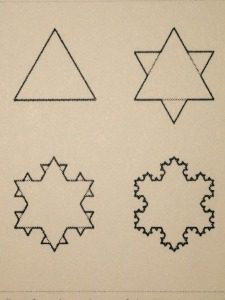 I’ll do you one better: the Koch Snowflake.
I’ll do you one better: the Koch Snowflake.
This is where Elsa makes her money.
Start with an equilateral triangle. Envision each leg of the triangle as comprising three equal segments. For each leg, draw another equilateral triangle that has the middle segment as its base. Remove the bases of the new triangles. Envision each (shorter) leg on the new structure as comprising three equal segments. For each new leg, draw another equilateral triangle that has the middle segment as its base.
Like the inimitable (and beautiful) Crystal Renn, it goes from sharp and angular to lush and curved the more it develops. [hr]
All of this might sound technical and pedantic, but I bet if you could review your oeuvre of doodles, you’d find a lot of fractals and semi-fractals you developed on the fly.
And that stands to reason, because fractals are all over the natural world. Tangible (as opposed to mathematical or geometric) fractals aren’t infinite, and don’t show “exact self-similarity,” but if you are tuned in, you will see examples of natural (and man-made) phenomena “branching,” or approximating the same pattern at different scales. Here are a few I managed to capture:
Fractals are everywhere: crystals, the circulatory system, broccoli, the rings of Saturn, frost, ocean waves, and lightning bolts.[hr]
Fractals have made their way into art, such as Katsushika Hokusai’s The Great Wave (shown above) and a cartoon by Farley Katz.[hr]
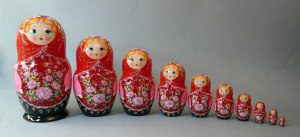
Though they aren’t actually (and don’t purport to be) fractals, the self-similarity of Matryoshka dolls is helpful in illustrating the concept of an exact replica at every scale.[hr]
Over the summer, the McNay Art Museum hosted “Beauty Reigns,” which featured elaborate contemporary art, some of which seemed fractal-inspired. To wit: “Medusa” (2013) by Susan Chrysler White.[hr]
Once you understand fractals, everything about parenting becomes easier.
Actually, that’s not true. However, a working knowledge of fractals gives you one more tool to engage and entertain your children. I taught my almost-five-year-old how to draw a quadratic cross. Older children are able to create Sierpinski Triangles and even the more complicated Koch shapes.[hr]
It’s fun to notice and point out fractals in the world around you. I recently noticed that the Volkswagon logo (minus the circle) is the first iteration of a fractal. Extrapolate it by causing each bottom point of each “W” to connect with the center apex of a new “W.”
Bonus points if you creep through a parking lot and take an accidental selfie in some other car owner’s chrome.[hr]
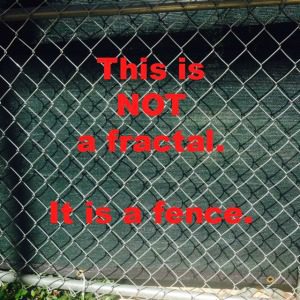 The first days are heady. You’ll think you see fractals everywhere. Remember, though, that to create a fractal, each level of the decomposition must create at least two scaled copies.
The first days are heady. You’ll think you see fractals everywhere. Remember, though, that to create a fractal, each level of the decomposition must create at least two scaled copies.
Go back to the quadratic cross: each level (a new line segment that bisects the prior line segment) creates two new line segments that each can be bisected. Or the Sierpinski Triangle: by removing the center triangle from the first-generation triangle, you create three scaled copies of the first-generation triangle.
For this reason, a checkerboard or chain-link fence is not a fractal. The pattern is repeated, but each iteration creates only one scaled copy.[hr]
An understanding of fractals gives you and your children one more lens through which to view and share the world. Our unending national obsession with Frozen gives you the perfect opportunity to use Elsa’s lyric as a jumping-off point for a subject that points to math, nature, and art.
I personally can’t wait for the much-awaited entirely speculative sequel, Frozen II: The Thaw, in which Anna burns it down with a torch song about palindromes.
Able was I ere I saw Elba, indeed.[hr]
Special thanks to my co-contributor, Inga, for her heads-up re: “Beauty Reigns.”




